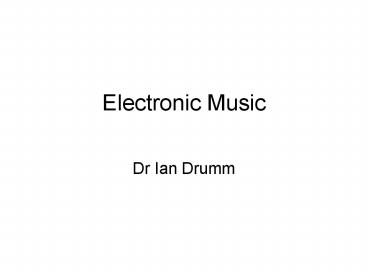Electronic Music PowerPoint PPT Presentation
1 / 20
Title: Electronic Music
1
Electronic Music
- Dr Ian Drumm
2
Subtractive Synthesis
- Aims
- An introduction to subtractive synthesis theory
and techniques - Learning Outcomes
- To introduce basic concepts
- Describe typical modular subtractive synthesiser
- Implement some example emulations
- Evaluation of advantages and disadvantages
- Explain simple subtractive vocoder
3
Basic Concept
- Start with sources to generate a complex waveform
- Filter to attenuate the relative amplitudes of
the constituent harmonics - Output to amplifier
4
Brief History
- Moog
- Prophet 5 (polyphony and midi control)
- Digital emulations (EMU, Virus, MS2000)
- Modular Software (Reaktor)
5
Sources
- Something broadband (rich in frequency content)
- minimoog sources (sawtooth, square, pulse train)
- also has noise source and option for external
input
6
Relaxation Oscillator
- charges capacitor to a given voltage
- triggers a comparator which initiates a discharge
- frequency can be varied by varying the current
used for charging. - voltage across the capacitor gives sawtooth
- voltage across the comparator gives pulse train
- Further waveshaping for other functions
7
VCO-Voltage Controlled Oscillator
- Provides simple source waveforms simultaneously
- Frequency controlled by input voltage
- Oscillator produces sawtooth and then other
waveforms derived - Rectify saw -gt triangle
- Hard clip saw -gt square
- Soft clip triangle -gtsine
8
Building the waveform
- Typically three oscillators mixed together
- Can control tuning and volume of each oscillator
- Can synchronise oscillators (i.e. choose whether
or not to keep phase relationships constant)
9
Modern Source Options
- Digital Waveshapes (e.g. Virus)
- Additive waveshape (e.g. Oscar)
- Vox Waveforms (e.g. Microkorg)
10
Filtering
- Traditional analogue filter types
- high-pass
- low-pass
- band-pass (combine low and high pass)
- Notch (combine low and high pass)
- Or a combination (e.g. voice formants look like
multiple band pass)
11
RC Filters
- Time to charge capacitor
- Voltage divided between resistor and capacitor
- At high frequencies capacitor doesnt change in
time hence less voltage across capacitor - Hence less signal out
12
Filter Response
- Cut off when 3dB drop from pass band
- RC (one pole) circuit gives 6dB / Octave
attenuation - RCL circuits give 12/dB and potential for
resonance Resonance (Q) at cut-off and self
oscillation
13
Moog ladder filter
- Current determined by a control voltage
- Current controls resistance of diodes
- Voltage across circuit filtered
- Some output sent back to circuit for resonance
14
VFC-Voltage Controlled Filter
- Cutoff frequency (and perhaps Q) controlled by
input voltage - Typical filter has fixed -6dB/oct slope and
constant Q - Voltage-controlled slope useful for emulative
synth but hard to implement
15
Filter control
- Control the movement of the cutoff point over
time using attack decay and release parameters
16
Digital Filtering
- FIR, IIR options
- For example simple biquad IIR filter
- Can control type, cutoff point, resonance, etc by
setting coefficients a0, a1, a2, b1, b2
appropriately
17
Envelope
- Attack, Decay, Sustain and Release
18
Modular System
- Typical synth has several VCOs, VCAs and envelop
generators, and one or two VCFs - Can connect anything to anything else
- A particular set of connections to make a
particular sound is called a patch
19
VCA Voltage Controlled Amplifier
- Provides control over signal amplitude
- Gain controlled by voltage input
- Several inputs provide simple mixing
20
Envelope generator
- Provides programmable control for an input type
- Usually ADSR type
- Analogue implementation usually gives
exponential, not straight lines

